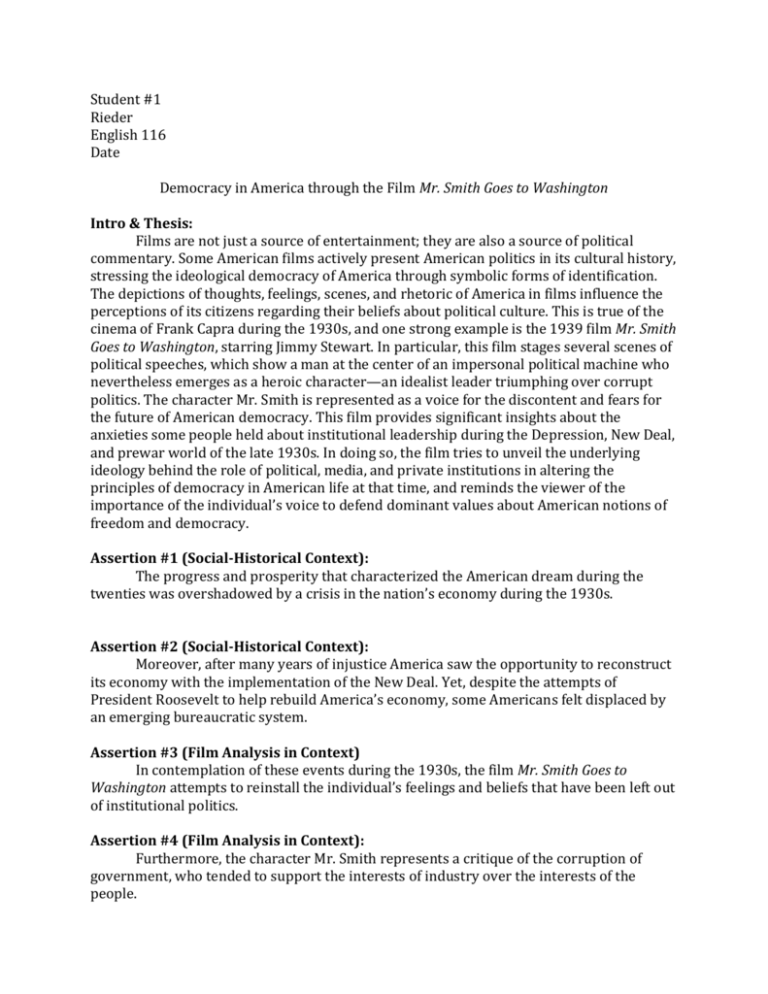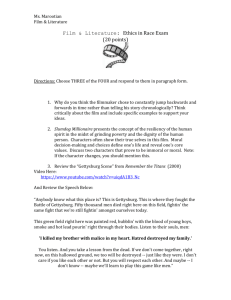Film Analysis: Sample Intro, Thesis, and Assertions
advertisement

Student #1 Rieder English 116 Date Democracy in America through the Film Mr. Smith Goes to Washington Intro & Thesis: Films are not just a source of entertainment; they are also a source of political commentary. Some American films actively present American politics in its cultural history, stressing the ideological democracy of America through symbolic forms of identification. The depictions of thoughts, feelings, scenes, and rhetoric of America in films influence the perceptions of its citizens regarding their beliefs about political culture. This is true of the cinema of Frank Capra during the 1930s, and one strong example is the 1939 film Mr. Smith Goes to Washington, starring Jimmy Stewart. In particular, this film stages several scenes of political speeches, which show a man at the center of an impersonal political machine who nevertheless emerges as a heroic character—an idealist leader triumphing over corrupt politics. The character Mr. Smith is represented as a voice for the discontent and fears for the future of American democracy. This film provides significant insights about the anxieties some people held about institutional leadership during the Depression, New Deal, and prewar world of the late 1930s. In doing so, the film tries to unveil the underlying ideology behind the role of political, media, and private institutions in altering the principles of democracy in American life at that time, and reminds the viewer of the importance of the individual’s voice to defend dominant values about American notions of freedom and democracy. Assertion #1 (Social-Historical Context): The progress and prosperity that characterized the American dream during the twenties was overshadowed by a crisis in the nation’s economy during the 1930s. Assertion #2 (Social-Historical Context): Moreover, after many years of injustice America saw the opportunity to reconstruct its economy with the implementation of the New Deal. Yet, despite the attempts of President Roosevelt to help rebuild America’s economy, some Americans felt displaced by an emerging bureaucratic system. Assertion #3 (Film Analysis in Context) In contemplation of these events during the 1930s, the film Mr. Smith Goes to Washington attempts to reinstall the individual’s feelings and beliefs that have been left out of institutional politics. Assertion #4 (Film Analysis in Context): Furthermore, the character Mr. Smith represents a critique of the corruption of government, who tended to support the interests of industry over the interests of the people. Assertion #5 (Film Analysis in Context) Besides confronting the political machines of power, Smith also realizes that in the modern world, the expression of ideas is controlled and ruled by powerful media forces. Assertion #6 (Film Analysis in Context) Indeed, under such circumstances of power and corruption, in the film the character Mr. Smith makes a direct connection with the theme of popular individualism and the role of presidents as the guardians of democratic values. This is clear with the use of mise-enscene, in particular American symbols and icons, at the opening of the film when Smith first visits the capitol. Student #2 Rieder English 116 Date Apocalypse Now: War Through the Eyes of a Madman In response to the Vietnam War, Francis Ford Coppola, with co-writer John Milius, wrote and directed the film Apocalypse Now (1978) to depict the horrors of war with an artist’s eye for detail and imagery. Despite the fact that this film produces an anti-war impression, Coppola incorporated many stylistic elements that represent the war as a piece of art rather than something to be abhorred; however, the main plotline and protagonist provide evidence that the film functions overall as a statement, in hindsight, of the war’s mismanagement and pointlessness. The narrator, Captain Willard, is represented as very unstable mentally, and he is sent on a mission into Cambodia to assassinate a fellow American, Colonel Kurtz, who has also gone insane and is waging a personal war that goes against the rules of conduct during wartime. The film uses the formal elements of sound, editing, and cinematography to construct Willard as a symbol of the insanity, futility, and contradictions of the Vietnam War, all of which had become dominant sentiments by the end of the 1970s when the film was produced. This is important because such sentiments tend to resist the cultural norms of patriotism and nationalism that Americans are expected to feel during and after military involvements. Assertion #1 (Social-Historical Context): Toward the end of the conflict in Vietnam, many Americans were displeased with the outcome and the progress that had been made as anti-war sentiments escalated. During and in the years immediately after the war, these ideas would extend into many corners of popular culture. Assertion #2: (Film Analysis) The film’s use of diegetic and non-diegetic sounds serves to emphasize the irony of the war as well as put the viewer inside of Willard’s mind, conveying the anti-war sentiments that go against American cultural pro-war norms. Assertion #2 (Film Analysis) Apocalypse Now, furthermore, not only uses sound to get the viewer inside Willard’s head, it also uses editing to connect the images and sound with what is most important to the protagonist so that we may understand the overall message of the futility of this and all wars. Assertion #3 (Film Analysis) The cinematography also forces the viewer to focus in on Willard’s state of mind so we sympathize with him and thereby aware of his anti-war feelings and the absurdity and abnormality of his illegal mission.



